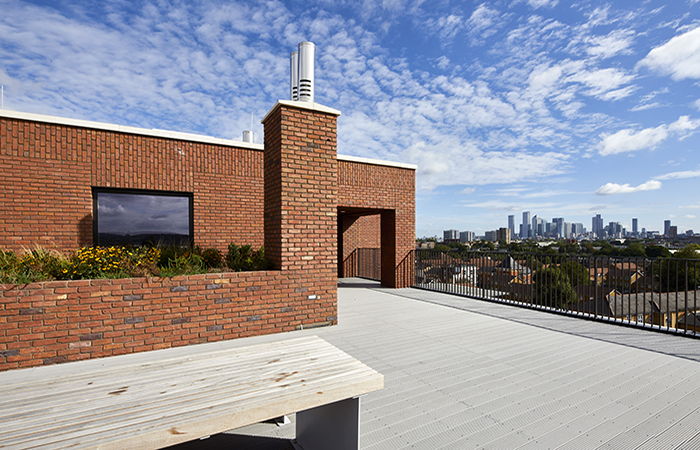The way spaces are designed can have a huge impact on the mental health of the people that use them. Whether it’s having access to the outdoors or room to work from home, promoting wellness in our developments is top of our agenda.
To explore what it’s like to live in a Pocket home, we spoke to former Pocket resident Ben Channon about what makes a building ‘healthy’ and how we can improve the wellness of our residents. Ben works for a consultancy called Ekkist, which focuses on enhancing human health and wellbeing through design.
Tell us a bit about yourself and what you do.
I trained as an architect and worked designing residential apartment buildings for the first 10 years of my career.
However, when I was about 25, I suffered with burnout and eventually anxiety; as a result, I became really interested in how our homes affect our mental health.
I started researching the connection between architecture and mental health, and I’ve now written two books on the subject: Happy by Design and The Happy Design Toolkit (which was published in March this year).
Since my own mental health experiences and writing my first book, I’ve been lucky enough to speak to businesses and universities as far afield as Auckland and Melbourne about the subject and even did a (slightly embarrassing!) TEDx talk. I now work at a ‘Design for Wellbeing’ consultancy called Ekkist – essentially, we help clients and design teams to create healthier buildings, so it’s the perfect job for me!
You lived in a Pocket home for four years. Do you think Pocket homes are designed with wellness in mind?

I moved into Cowleaze Road KT2 in 2018 and only just moved out to relocate to Bath. I love the Pocket concept because it’s so difficult for first time buyers to get on the housing ladder, especially in London.
The design team at Pocket are obviously facing a tricky challenge – how do you create homes that are small enough to be affordable, while still making sure they are great places to live? I always felt that my Pocket home met that brief very well, for a few reasons.
Firstly, it had lots of glazing, with generous floor-to-ceiling windows throughout. These could open fully, too, meaning it was easy to get lots of natural light and fresh air into the space. The layout was very efficient, with almost no wasted space given over to lengthy corridors.
As a result, the apartment was very ‘liveable’, despite not being enormous. I also loved that we had a generous cycle store, meaning that almost everyone in the building cycled (particularly as we were very close to Richmond Park) – something that is beneficial for not only physical fitness but mental health, too.
The pandemic highlighted how much our living spaces can affect our mental health. What is your view on the impact communal spaces can have on residents’ mental health?

Absolutely, and I was involved with a couple of research projects that both demonstrated how peoples’ homes and environment had an enormous impact on how they felt during lockdown.
Communal spaces have a huge role to play in supporting better mental wellbeing. Interaction with nature has been demonstrated time and again to have a significant positive impact on mood, as it can activate our parasympathetic nervous system, which helps us to relax (it’s the opposite of the sympathetic nervous system, which is responsible for our ‘fight or flight’ response). So, providing communal gardens packed with planting or offering views of nature can be powerful.
The social element is incredibly important too, as we found during lockdown. Loneliness has been shown to correlate with higher morbidity rates and can be as bad for our physical health as smoking or obesity. Being able to sit on a roof garden with neighbours during lockdown – even at either ends of the space – was helpful in maintaining a sense of connection and social interaction.
What’s the most interesting thing you’ve discovered about how design can affect mental health, wellbeing and happiness?
That’s a tricky question – there are lots of ways it impacts us! Perhaps it’s just how much our sense of personal space can play a huge role in how we feel and behave. A good example of this is research that has been done in prisons, which has found that lower ceilings or narrow spaces can impact physiological stress levels and lead to higher levels of stress hormones being released.
It is also interesting to me just how strongly we form connections to places and homes – and I was definitely very sad when we moved out of our Pocket flat, perhaps because it was our first home! The concept is known as ‘place attachment’ among environmental psychologists, and some research suggests that our connection to our homes can be as strong as our connection to our pets or even family members!
Finally, one of the most encouraging things for me has been to see just how much value the public is now placing on having a healthy place to live or work. We did some research earlier this year in which most people said not only was a healthy home important to them but that they’d pay more for it – and most respondents argued that a healthy home was actually more important to them than a ‘green’ one.
Tell us about your new book, ‘The Happy Design Toolkit’.

The book is really a sort of ‘box of tricks’ that we can all use in our homes (or, in fact, any building) to ensure they better support our mental wellbeing. These range from healthy materials that engage our senses to adaptable workspaces (Very relevant right now!) or even larger elements like rooftop allotments or spaces that offer us that chance to socialise more.
I decided to write the book because my first one looked more at the conceptual idea of ‘what affects our mental health in a building’ – but architects and interior designers kept asking me for ideas or ways to put it into their projects. Because it’s all based around real-world examples, there are loads of drawings of beautiful architecture projects in there too, which I really enjoyed illustrating.
What do you think are the biggest priorities for younger people looking to buy their first home in 2022?
Well, the research shows us that a home that will take care of their health and make them feel great is high on the agenda right now, perhaps because of Covid-19 and the risk of potential lockdowns in the future. This has obviously meant that we expect more from our homes and spend more time in them, and this has been coupled with a greater public understanding of the importance of issues like ventilation.
Much like Millennials and Gen-Zs have resisted bad or toxic workplace cultures, I also expect pushback against the traditional ‘cheaper apartment building’ model of lower ceilings, smaller windows and cheaper materials. I’m therefore expecting more and more residential developers to focus on improving this aspect of what they do, and I’m hoping that in five years’ time there will be just as much emphasis on health as there now is on sustainability.
That said, the environmental problem isn’t going anywhere, and coupled with the energy crisis, we know consumers this year will also want to know their home won’t be expensive to run. With the emergence of a generation more concerned with the ethics of what they buy than ever before, issues like the circular economy, ethical product sourcing and the moral stance of developers are likely to become ever more important issues, too.
Ultimately, these are all good things for the market but especially for those developers who already have a strong focus on quality and on customer happiness. And eventually, it should result in better homes for everybody – which is something we should all be behind!
To hear more stories from Pocket residents, check out our interview with India and Hallam or watch our case studies. You can also find out more about how we promote wellness in Pocket developments.

